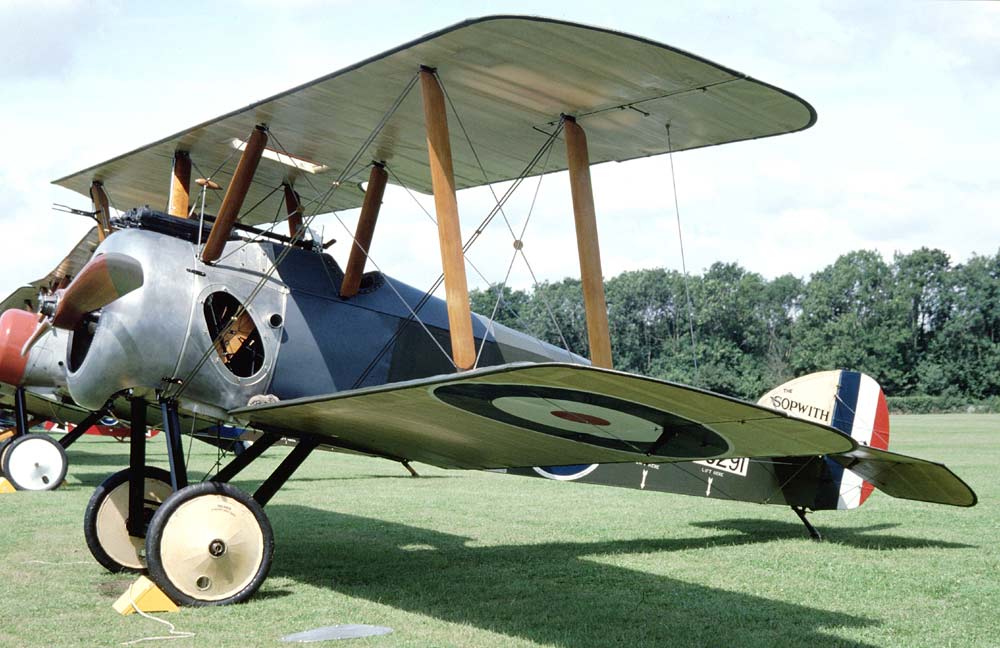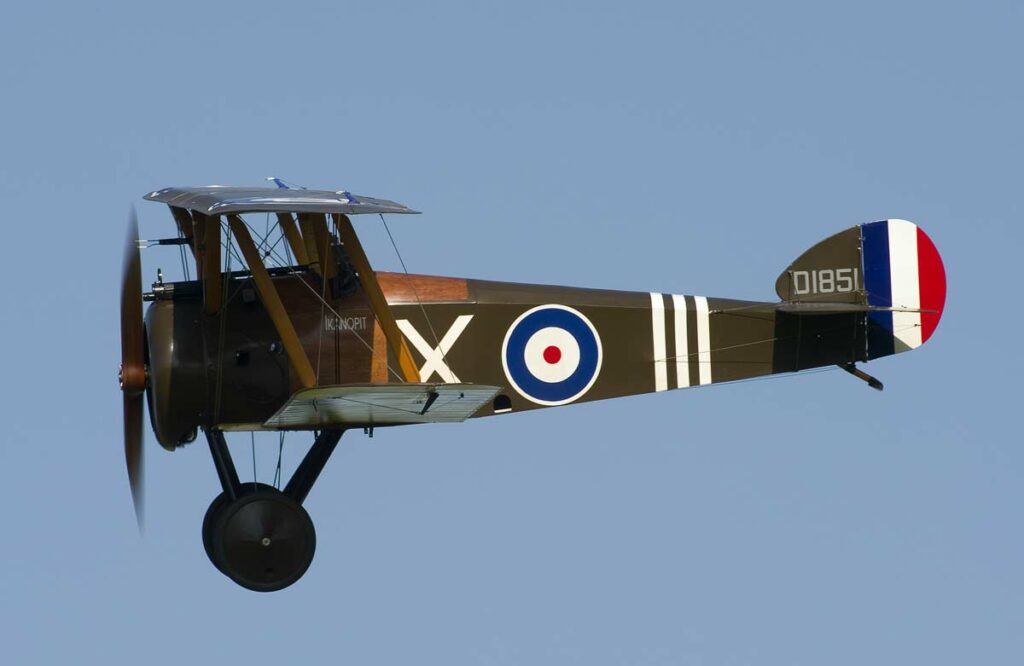The Sopwith Camel, a British First World War single-seat biplane fighter, noted for its maneuverability and powerful rotary engine, served as a key component in aerial combat. This article explores the Sopwith Camel, a significant World War I fighter aircraft. We delve into its history, design, performance, and military use, detailing its development, technical specifications, combat roles, and lasting impact on aerial warfare.
The Sopwith Camel is a name synonymous with World War I aviation. It emerged as a symbol of air superiority during the conflict, playing a pivotal role in the aerial dimension of warfare.

History of the Development of the Sopwith Camel
Context and Need
In the early 20th century, aviation was in its infancy. The outbreak of World War I in 1914 transformed aircraft from reconnaissance tools into weapons of war. The Allies urgently needed superior fighters to combat the German air force’s growing capabilities.
Development Objective
The Sopwith Aviation Company, under the leadership of Thomas Sopwith, aimed to create a nimble, fast, and powerful fighter that could gain air superiority.
Launch of the Program
The development program for the Sopwith Camel began in 1916, amid the escalating need for effective fighters on the Western Front.
First Flight
The prototype took its maiden flight on December 22, 1916. Its performance during trials was impressive, leading to quick adoption by the Royal Flying Corps and the Royal Naval Air Service.
The Aircraft’s Significance
The Sopwith Camel was crucial in turning the tide of aerial combat in favor of the Allies. Its agility, coupled with effective firepower, made it a formidable opponent against German aircraft.
Design of the Sopwith Camel
Technical Specifications
- Length: 18 ft 9 in (5.72 m)
- Wingspan: 28 ft (8.53 m)
- Height: 8 ft 6 in (2.59 m)
- Wing area: 231 sq ft (21.46 sq m) Powerplant
- Engine: Clerget 9B Rotary, 130 hp (97 kW)
- Alternative engines used: Le Rhône 9J, Bentley BR1 Design Advantages
The Camel’s rotary engine provided exceptional maneuverability, crucial in dogfights. Its compact design allowed for tight turns and agile movements. Drawbacks
However, its rotary engine also made it challenging to fly, especially for inexperienced pilots. The torque effect required skilled handling to avoid fatal spins. Impact on Aircraft Development
The Camel’s design influenced future fighter aircraft, setting a standard in agility and firepower.
Performance of the Sopwith Camel
Engine and Power
Equipped with a Clerget 9B rotary engine, the Camel delivered 130 horsepower. This power was substantial for its time, especially when considering the aircraft’s light frame.
Speed and Altitude
- Maximum Speed: 113 mph (182 km/h)
- Service Ceiling: 19,000 ft (5,791 m) Range
- Operational Range: 300 miles (483 km) Comparative Analysis
When compared to its contemporaries like the German Albatros D.III, the Camel was superior in maneuverability, though slightly lacking in speed.
Military Use and Combat of the Sopwith Camel
Armament
The Camel was armed with twin synchronized Vickers machine guns, making it deadly in dogfights.

Combat Use of the Sopwith Camel
First Engagement
The Sopwith Camel’s combat debut in June 1917 marked a significant shift in the air war over the Western Front. Its introduction into battle was timely, as the Allied forces were desperately seeking a way to regain air superiority from the German Luftstreitkräfte.
Role in the Battle of Cambrai
The Battle of Cambrai, which occurred in November 1917, was one of the most notable engagements involving the Camel. This battle was significant for the use of tanks in a massed formation for the first time, and air support was crucial. The Camel played a pivotal role in providing air cover for the ground forces, engaging in dogfights to keep German aircraft at bay. It proved effective in protecting the tanks and infantry from aerial attacks, thus contributing to the initial success of the campaign.
Dogfights Over the Western Front
The Camel’s superior maneuverability and firepower made it a fearsome adversary in dogfights. Its twin synchronized Vickers machine guns allowed it to fire directly through the propeller, giving it a significant advantage in aerial duels. Pilots could engage enemy aircraft head-on, a tactic that was not viable for many other fighters of the time.
Encounters with Notable Enemy Aircraft
The Camel regularly engaged with formidable German aircraft like the Albatros D.III and the Fokker Dr.I. The latter, famously flown by Manfred von Richthofen, the “Red Baron,” was one of the few aircraft that could match the Camel’s maneuverability. These encounters were often intense and required skill and tactics from the pilots.
Impact on Air Superiority
The introduction and deployment of the Camel had a marked impact on the balance of air power. It allowed the Allies to launch more aggressive aerial campaigns, intercepting German reconnaissance and bombing missions effectively. The Camel’s success in dogfights and its ability to escort and protect Allied bombers and reconnaissance planes was crucial in diminishing the effectiveness of German air operations.
Beyond the Western Front
While most famous for its service over the Western Front, Camels were also deployed in other theaters of World War I, including the Middle East and the Italian Front. In these regions, they faced different challenges, such as varied climate conditions and diverse enemy tactics, yet they continued to perform effectively.
Legacy in Combat
The Sopwith Camel’s combat record is impressive. It is credited with shooting down more enemy aircraft than any other Allied fighter during the war. Its impact extended beyond mere numbers; the Camel was a morale booster for the Allied forces and a symbol of hope during some of the conflict’s darkest days.
The Sopwith Camel’s combat use, especially during the Battle of Cambrai and in numerous dogfights over the Western Front, was pivotal in shifting the tide of aerial warfare in favor of the Allies during World War I. Its aggressive, effective, and versatile performance showcased the rapid evolution of military aviation and tactics during the conflict.
Competing Aircraft
Its main adversaries included the German Albatros D.III and the Fokker Dr.I.
Sales and Usage
The Camel was used by several Allied forces and sold to countries like Belgium and Greece. After the war, it continued to serve in various roles before being phased out.
End of Service
The Camel was eventually replaced by more advanced aircraft like the Sopwith Snipe. Its last military use was in the early 1920s.
The Sopwith Camel stands as a testament to innovation and effectiveness in aerial combat during World War I. Its legacy is marked by its crucial role in achieving air superiority for the Allies and its influence on future fighter aircraft design.
Back to the Warbirds section.